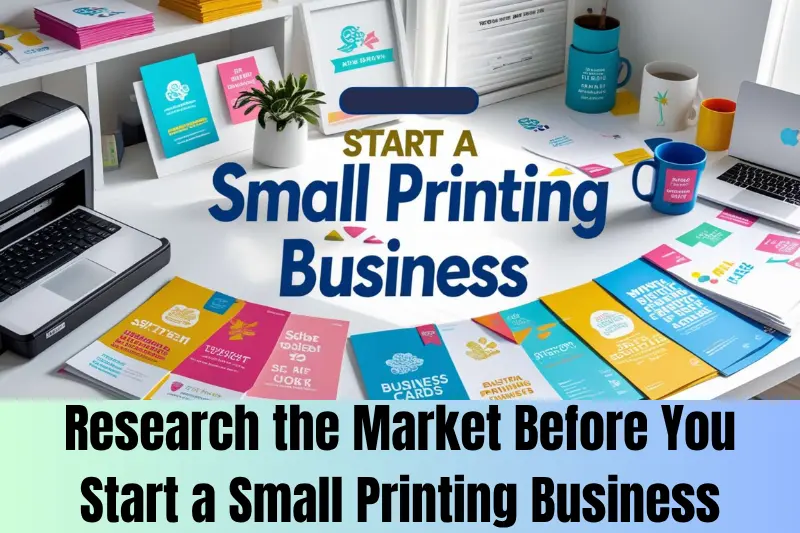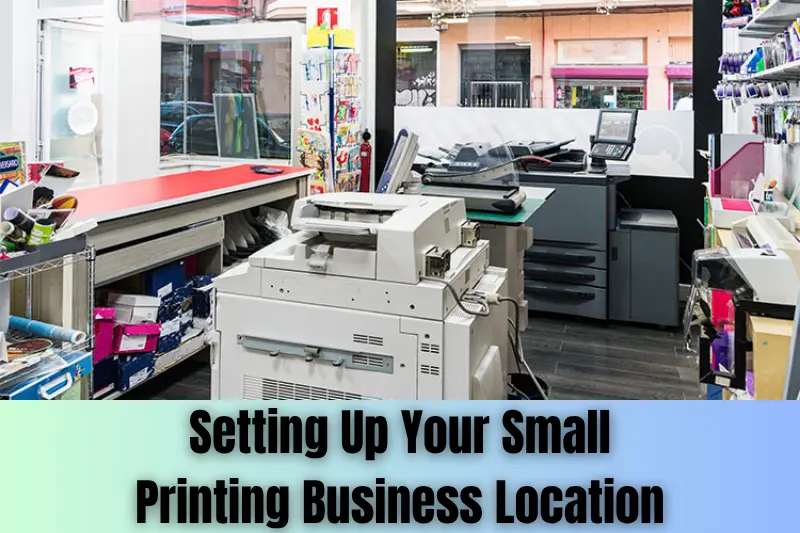Starting a small printing business can be an exciting and rewarding venture. If you’re looking for a way to turn your creativity into a profitable business, this could be the perfect opportunity for you. In this article, we’ll guide you step-by-step on how to start a small printing business, from understanding the market to setting up your equipment.
Whether you’re passionate about custom T-shirts, business cards, or personalized products, starting a small printing business gives you the chance to tap into a growing demand for unique, high-quality prints. Let’s dive in and explore how you can begin your journey toward becoming a successful printing business owner!
Research the Market Before You Start a Small Printing Business

Before jumping into your small printing business, it’s important to understand the market you’re entering. Doing thorough market research will help you identify your target audience, competition, and potential demand for your services. Here’s how you can approach this step:
Understand the Demand for Printing Services
- Identify which printing services are in high demand in your area.
- Look for niches like business cards, custom t-shirts, posters, and promotional materials.
- Research trends in the printing industry to see what products are popular.
Identify Your Target Market
- Determine who your potential customers are: businesses, schools, individuals, etc.
- Think about what type of printing services they would need the most.
- Consider targeting both local and online markets to expand your reach.
Analyze Competitors in Your Area
- Research other printing businesses in your area to see what they offer and how they price their services.
- Look for gaps in the market or areas where you can offer something unique.
- Check customer reviews of competitors to understand their strengths and weaknesses.
Evaluate Pricing and Profitability
- Study how much other printing businesses charge for similar services.
- Find out what pricing strategies work best for your target market.
- Understand the cost of printing materials and equipment to estimate your profit margins.
You may also like it:
Personal Finance Guide: Tips for Financial Success
Smart Home Trends: Top Innovations for 2025
Easy Budgeting Tips: Manage Your Money Smartly
Choose the Right Printing Services for Your Small Business
Choosing the right printing services is a crucial step in starting your small printing business. It will define what products you can offer to your customers and set you apart from competitors. Here’s how to decide which services to offer:
Decide on the Types of Printing Services
- Determine whether you want to focus on digital printing, screen printing, or offset printing.
- Each method has its own advantages: digital printing is fast and affordable for small orders, while screen printing is great for bulk orders.
- Understand which methods are in demand in your market and align them with customer needs.
Focus on High-Demand Products
- Offer popular printing products like business cards, brochures, banners, and custom t-shirts.
- Explore specialty items such as mugs, bags, or phone cases, which are trending in personalized gifts.
- Consider packaging options if you’re targeting businesses that need custom labels or packaging designs.
Assess Your Skills and Equipment Needs
- If you’re just starting, pick printing services that match your budget and technical expertise.
- Some printing techniques require more advanced equipment and skills, so ensure you’re comfortable with the learning curve.
- Research what equipment is needed for the types of printing you plan to offer, and decide if you want to invest in high-end machinery.
Consider the Production Time and Costs
- Understand the production timelines for different types of prints—some services are quicker than others.
- Factor in the costs of printing materials, ink, and machinery, as these will impact your pricing and profitability.
- Offering a fast turnaround time can give you a competitive edge, especially for clients needing urgent printing jobs.
Setting Up Your Printing Equipment for a Small Business
Setting up the right printing equipment is essential for delivering high-quality prints and ensuring smooth operations in your small printing business. The equipment you choose should match the services you’re offering and your budget. Here’s a guide to help you choose and set up the right equipment:
Determine the Type of Printing Equipment You Need
- The type of printing service you offer will guide the equipment you need, such as digital printers, screen printers, or heat press machines.
- For custom t-shirts, a heat press and vinyl cutter may be necessary, while for business cards, a digital printer would be more suitable.
- Research the equipment required for each printing service to ensure you buy the right machines.
Choose Between New and Used Equipment
- New equipment tends to be more expensive but may come with warranties and modern features.
- Used equipment can save money upfront but may require repairs or maintenance. Always check its condition before purchasing.
- Weigh the pros and cons of buying new vs. used equipment based on your budget and business needs.
Consider Space and Setup Requirements
- Ensure you have enough space for your equipment, considering the size of printers, cutters, and other machines.
- Set up your workspace efficiently to keep your equipment accessible and organized, which will improve workflow and productivity.
- Make sure your location has adequate electrical capacity and ventilation for the machinery.
Factor in Maintenance and Operating Costs
- Budget for regular maintenance and repairs of your equipment to keep it running smoothly.
- Consider the cost of supplies such as ink, paper, vinyl, and other printing materials that will be needed regularly.
- Look into training for yourself or your employees on how to properly operate and maintain the machines to avoid costly mistakes.
Building Your Brand and Business Identity
Building a strong brand and business identity is essential for standing out in the competitive printing industry. Your brand will represent who you are and what your business offers. Here’s how to create a memorable and professional brand for your small printing business:
Create a Unique Business Name and Logo
- Choose a business name that is catchy, easy to remember, and reflects your printing services.
- Design a professional logo that communicates your brand’s values and expertise in printing.
- Make sure your logo works well on all platforms, including business cards, websites, and social media.
Develop a Consistent Brand Message
- Decide on a message that clearly explains what makes your printing business different from others.
- Focus on quality, customer service, and reliability in your messaging to attract customers.
- Ensure your brand message is consistent across all marketing materials, both online and offline.
Build an Online Presence
- Create a website for your printing business where customers can learn about your services and place orders.
- Set up social media accounts on platforms like Facebook, Instagram, and LinkedIn to showcase your work and engage with potential clients.
- Include customer testimonials and high-quality images of your prints to build trust with visitors.
Develop a Professional Brand Image
- Use a consistent color scheme, fonts, and design style across all branding materials to make your business look professional.
- Make sure all printed materials (business cards, brochures, etc.) match your brand image.
- Keep your business premises neat and well-organized, as this also contributes to your brand’s professional image.
Setting Up Your Small Printing Business Location

Choosing the right location for your small printing business is critical to your success. It affects your ability to attract customers, manage costs, and grow your business. Here’s how to set up your printing business location:
Choose Between a Home-Based or Commercial Location
- A home-based business can save on rent and overhead costs, making it ideal for small-scale operations.
- A commercial location may offer more visibility and space but comes with higher rent and other expenses.
- Consider your target market and whether you need a physical storefront to attract local customers.
Consider Accessibility and Visibility
- Your location should be easily accessible for both customers and suppliers, with good road access and parking.
- If you choose a commercial location, ensure it’s visible to passersby, especially if you want to attract walk-in customers.
- Being near other businesses, schools, or offices can help generate foot traffic and potential clients.
Evaluate Space Requirements
- Make sure your location provides enough space for printing equipment, storage, and an organized workspace.
- If you plan to offer delivery or customer pick-up services, ensure there is enough room for packaging and a loading area.
- Space for inventory, supplies, and customer interaction should also be considered when setting up your location.
Check Local Zoning and Permits
- Ensure the location complies with local zoning laws and that you can legally operate a printing business there.
- Obtain any necessary permits and licenses before opening to avoid legal issues.
- Research local regulations about signage, business hours, and noise levels to ensure smooth operation.
Keep Costs in Mind
- Calculate the cost of rent, utilities, insurance, and any renovations needed to prepare the space.
- Factor in ongoing operational costs, such as maintenance, security, and supplies.
- Balance the costs of a prime location with your business budget to avoid overspending in the early stages.
Pricing Your Printing Services
Setting the right prices for your printing services is crucial to attract customers while ensuring profitability. You need to strike a balance between competitive pricing and covering your costs. Here’s how to set the right pricing strategy for your small printing business:
Understand Your Costs
- Calculate the cost of materials such as paper, ink, vinyl, and other supplies for each printing job.
- Factor in the cost of equipment maintenance, utilities, and your labor costs.
- Don’t forget about overhead costs, like rent, insurance, and marketing, which also need to be covered by your pricing.
Research Your Competitors’ Pricing
- Check what other printing businesses in your area are charging for similar services.
- Understand the market rate and determine whether you can offer lower prices or provide more value to justify a slightly higher price.
- Look at their pricing structure—whether they charge by the hour, per item, or offer package deals.
Offer Different Pricing Tiers
- Create pricing tiers based on the volume of prints ordered (e.g., discounts for bulk orders).
- Consider offering a basic, standard, and premium tier for different types of printing quality and turnaround times.
- Offer package deals for products that customers frequently order together (e.g., business cards and letterheads).
Factor in Discounts and Promotions
- Offer discounts for first-time customers, loyal clients, or bulk orders to encourage repeat business.
- Consider running seasonal promotions to increase business during slower months.
- Keep track of discount programs and ensure they align with your profit margins.
Determine Your Profit Margin
- Set a reasonable profit margin that covers all your costs and leaves room for business growth.
- A common markup for printing services is 30%-50%, depending on the complexity and volume of the job.
- Regularly review your pricing strategy to adjust for rising costs or changes in market demand.
Be Transparent with Pricing
- Clearly communicate your prices to customers so there are no surprises at checkout.
- Display pricing on your website or in-store to make it easy for potential customers to see.
- Offer itemized quotes for larger jobs so customers understand the breakdown of costs.
Marketing Your Small Printing Business
Effective marketing is key to attracting customers and growing your small printing business. Whether you focus on online or offline strategies, a strong marketing plan will help you build brand awareness and increase sales. Here’s how to market your printing business successfully:
Build an Online Presence
- Create a professional website that showcases your services, pricing, and portfolio of previous work.
- Use social media platforms like Facebook, Instagram, and LinkedIn to engage with potential customers and post examples of your work.
- Optimize your website for SEO (Search Engine Optimization) so customers can easily find your business when searching online.
Leverage Local SEO and Google My Business
- Set up a Google My Business profile to make your printing business visible in local searches.
- Encourage customers to leave reviews on Google and other local directories to build trust with new clients.
- Use location-based keywords on your website and social media to target customers in your area.
Network with Local Businesses
- Build partnerships with local businesses that may need printing services, such as restaurants, schools, and event organizers.
- Offer referral discounts to existing customers who refer new clients to your printing business.
- Attend local business networking events, trade shows, or fairs to promote your services to a broader audience.
Offer Promotions and Discounts
- Run special promotions or seasonal discounts to attract new customers and encourage repeat business.
- Offer bundle deals where customers can purchase multiple items at a discounted price, such as business cards and flyers.
- Use limited-time offers to create urgency and encourage customers to act quickly.
Invest in Paid Advertising
- Use Google Ads to target customers searching for printing services in your area.
- Consider running Facebook and Instagram ads, especially if you offer customized products like t-shirts or mugs.
- Invest in local print advertising such as flyers or postcards, especially if you are targeting businesses or local events.
Create a Referral Program
- Set up a referral program to encourage happy customers to refer your printing services to others.
- Offer incentives, such as discounts or free products, to customers who refer new clients.
- Ensure your referral program is easy to understand and track, so customers feel motivated to participate.
Engage with Customers through Email Marketing
- Collect email addresses from customers and offer them value through regular newsletters.
- Send updates on promotions, new services, or upcoming events to keep your customers engaged.
- Personalize your emails with special offers for loyal customers or those who haven’t used your services in a while.
Managing Finances and Growing Your Small Printing Business
Managing your finances effectively is crucial for the success and growth of your small printing business. Proper financial planning will help you stay on track, reduce unnecessary costs, and reinvest in your business to expand. Here’s how to manage your finances and scale your printing business:
Create a Detailed Budget
- Start by listing all your business expenses, including equipment costs, materials, rent, salaries, and utilities.
- Set aside a portion of your income for taxes and unexpected expenses to avoid surprises.
- Track your income and expenses regularly to ensure you stay within your budget and identify any areas for cost-saving.
Monitor Cash Flow
- Keep a close eye on your cash flow to ensure you have enough working capital for day-to-day operations.
- Use accounting software to track your sales, expenses, and profit margins.
- Be mindful of accounts receivable (money owed to you) and accounts payable (money you owe) to maintain a steady cash flow.
Reinvest Profits into Your Business
- Use the profits from your printing business to reinvest in new equipment, marketing campaigns, or employee training.
- Prioritize investments that will directly improve your product quality, efficiency, and customer satisfaction.
- Consider expanding your service offerings, such as adding new printing techniques or offering online ordering, to attract more customers.
Build a Financial Safety Net
- Set up an emergency fund to cover unexpected costs, such as machine repairs or slow sales periods.
- A good rule of thumb is to save at least 3 to 6 months of operating expenses in an easily accessible account.
- Having a financial cushion will give you peace of mind and allow you to make important business decisions without the stress of running out of cash.
Minimize Operational Costs
- Look for ways to reduce operational costs, such as negotiating with suppliers for better rates or buying in bulk.
- Consider outsourcing certain tasks, like bookkeeping or IT support, to reduce labor costs.
- Regularly review your business processes and identify inefficiencies that could be streamlined to save time and money.
Track Financial Performance and Set Goals
- Set clear financial goals for your business, such as reaching a specific revenue target or increasing profit margins.
- Use your past financial data to evaluate the performance of your printing business and adjust your goals accordingly.
- Regularly assess your financial progress and make adjustments to your budget, pricing, or marketing strategies as needed.
Seek Funding for Expansion
- If you plan to expand your printing business, consider applying for a small business loan or seeking investors.
- Having a solid business plan and financial history will increase your chances of securing funding.
- Use the funds strategically to scale your business, whether it’s investing in new equipment, hiring more staff, or opening a new location.
Conclusion
Starting and growing a small printing business can be a rewarding journey when you manage your finances and operations wisely. By researching the market, choosing the right equipment, setting competitive prices, and marketing effectively, you can build a strong foundation for success.
Don’t forget to reinvest in your business and stay on top of your finances to ensure steady growth. With the right planning and dedication, your small printing business can thrive and stand out in the market!
Common FAQs for Starting a Small Printing Business
What types of printing services can I offer?
You can offer services like digital printing, screen printing, and offset printing. Some popular products include business cards, flyers, t-shirts, banners, and custom merchandise.
How much does it cost to start a small printing business?
The cost can vary depending on the equipment you choose, but it generally includes printing machines, materials, a workspace, and marketing costs. Starting small with a home-based setup can help keep initial costs lower.
Do I need a business license to start a printing business?
Yes, most locations require a business license to operate legally. Check with your local authorities to get the necessary permits and licenses for your area.
Can I run a printing business from home?
Yes, many small printing businesses start from home, especially if you focus on digital printing or offering smaller-scale products. Just ensure you have enough space and equipment.
How do I price my printing services?
Price your services by considering the cost of materials, labor, equipment, and overhead. Research local competitors to make sure your prices are competitive while still covering your costs.
How can I get customers for my printing business?
You can market your business online through social media, Google My Business, and your website. You can also network with local businesses and offer promotions to attract customers.
What equipment do I need to start a printing business?
The equipment you’ll need depends on the type of printing you want to offer. Common items include printers, cutters, heat presses, and software for design. Start with basic equipment and upgrade as your business grows.
Bonus Points
- Offer Customization Options: Providing personalized products like custom t-shirts, mugs, and banners can attract more customers who want unique items for their businesses or events.
- Focus on Quality Control: Ensure that every print job meets high standards to build a reputation for quality and reliability, which can lead to repeat business.
- Start Small and Scale Gradually: Begin with a few core services and expand as your customer base grows. This allows you to manage costs and reduce risks.
- Utilize Online Platforms: Set up an easy-to-use online store to allow customers to place orders from anywhere, increasing your reach and convenience.
- Stay Updated with Industry Trends: Keep an eye on new printing technologies, techniques, and materials to stay competitive and offer innovative products.
- Provide Excellent Customer Service: Always prioritize customer satisfaction by being responsive, friendly, and offering quick solutions to any issues.
- Build Strong Supplier Relationships: Work closely with suppliers to get better deals on materials and printing supplies, which can improve your profit margins.
- Track Your Competitors: Keep an eye on what other local printing businesses are doing, and look for opportunities to improve your offerings or find a niche.
- Leverage Word of Mouth: Encourage satisfied customers to recommend your services to others by offering referral discounts or incentives.
- Create a Loyalty Program: Reward repeat customers with discounts or free products to build loyalty and keep them coming back for future orders.
You may also like it:
Saving Money Tips for Students: Master Your Finances Now!
Startup Marketing Strategies: Boost Your Business Fast







